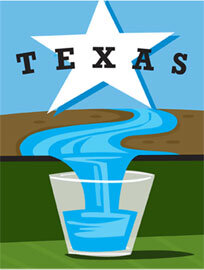
Success Stories
Martindale Public Outreach Event
Lake Houston Project
Lake Tawakoni Project
Comal & Hays Counties Well Head Protection Plant
Martindale Public Outreach Event
Entity: Martindale Water Supply Corporation
Contact Person/Phone Number: Steve Fonville
Date(s): April 26, 2009
Location: Martindale Public Outreach Event
After joining the Source Water Assessment and Protection Program, the Martindale Water Supply Corporation decided to conduct a public outreach campaign as part of the town's annual Fun Fest event. On April 25, 2009, Steve Fonville of Martindale WSC and a representative of the SWAP program hosted a booth at Fun Fest, handing out informational brochures and free promotional items such as refrigerator magnets, key chains, and toy water bottles. Each of the items helps residents remember to protect their water sources when they get back home. Children, in particular, enjoyed the free items. Fonville said the event was a success, allowing the WSC to reach out to the community, especially to educate residents about chemicals such as atrozine, common in weed killers, that are creeping into the water system. "Everyone's thinking about water now," he said.
Any system that joins the SWAP program can host a similar event in their community.
Lake Houston Project
Entity: City of Houston, Public Works Department; Public Utilities Division, Drinking Water Operations
Contact person/phone number: Alex Van Keuren, Deputy Assistant Director, 713-837-0548
Date(s): April 2006 to present
Location: Lake Houston
Lead agencies: Texas Commission on Environmental Quality, United States Geological Survey, City of Houston
Lake Houston is an 11,000 acre water body constructed by the City of Houston in 1954. The lake has historically been used for recreational purposes, but is now also the drinking water source for approximately 1 million customers. The lake provides water to both the Northeast Water Purification Plant and the East Water Purification Plant (both owned and operated by the City).
The water quality in Lake Houston is generally good, however water quality specific challenges include fast moving flow, poor clarity, seasonal variations that cause taste and odor problems (blue/green algae proliferation, high nutrient loadings; naturally occurring compounds [Geosmin and MIB]; oxygen deficiencies at lower depths; thermal stratification and seasonal lake turnovers).
The City installed 20 solar powered laminar flow hypolimnetic circulators, “Solar Bees”, around the plant intake. In addition, three floating water quality monitoring stations were constructed and installed to provide real-time monitoring of water quality upstream, in-stream, and down stream of the Solar Bees. Each monitoring station records water quality at four depths. Water quality parameters monitored include: temperature, pH, dissolved oxygen, turbidity, conductivity, chlorophyll, nitrogen, phosphorus. Data from the monitoring stations are uploaded wirelessly and are available for viewing on the USGS website.
The project was funded through an agreement between the City of Houston and the USGS.
Measurable outcomes to date include:
- Almost immediate improvements in water clarity (Secchi Depth), proliferation of aquatic species not previously seen
- Dampening effect on variation in water quality
- Reduction in chemical treatment costs
- Avoidance of seasonal algae blooms and T&O events associated with lake turnovers
- Decreased customer complaints
Lake Tawakoni Project
Entity: Cash Special Utility District
Contact person/phone number: Clay Hodges, General Manager, 903-883-2695
Date(s): Final Report September 22, 2006
Location: Lake Tawakoni, Hunt County, Texas
Lead agencies: Texas Commission on Environmental Quality, Texas Water Development Board
Lake Tawakoni in Hunt County, Texas, is at risk as a result of infiltration of pesticides and fertilizers, urban runoff, leaks from pipelines and as well as leaking septic tanks and landfills. The Cash Special Utility District began to develop a source water protection program to protect the public water systems that use the lake as a drinking water supply source and to improve the lake water quality.
The best management practices implemented by included educating boat and water craft users, encouraging septic tank maintenance, and enforcing current regulations. As part of this effort, signage was posted at boat ramps and public access points around the lake.
Signage was funded through the Texas Water Development Board. During 2006 the District won an award from the TCEQ for "Substantial Source Water Protection Program Implementation" on Lake Tawakoni. To be recognized by this award, a source water protection project must have been completed which identifies and ground-truths the potential sources of contamination identified in the source water assessment and implements at least one BMP. (See Substantial Source Water Protection Program Implementation Award for more information).
for more information).
Comal & Hays Counties
Comal & Hays Counties Well Head Protection Plan
Entity: Edwards Aquifer Authority
Contact person/phone number: John Hoyt, 210- 477-5136
Date(s): Mid-2006 through mid-2007
Location: Edwards Aquifer Recharge Zone in Comal and Hays counties
Lead agencies: Texas Commission on Environmental Quality, Edwards Aquifer Authority
The Edwards Aquifer system is vulnerable to contamination in the unconfined zone, through various pathways such as cracks, fractures and faults [Standen and Opdyke, 2004]. Hazardous substances and pollutants that reach the unconfined zone can affect the public water supply and consequently the health of those who rely on the aquifer system as their primary drinking water source [Aquifer Guardians in Urban Areas, 2008].
To protect the public water supply wells located in the Edwards Aquifer Recharge Zone in Comal and Hays Counties, TCEQ and the Edward Aquifer Authority worked together to assist water purveyors by providing well head protection information which could be used to develop source water protection plans. Using these data, TCEQ contractors compiled various datasets to identify potential sources of contamination in the vicinity of public water supply wells. The EAA provided water well and petroleum storage tank data to supplement the TCEQ datasets and served as a liaison between TCEQ contractors and water purveyors.
The project final report, titled A Drinking Water Protection Strategy, Edwards Aquifer, can be used by water purveyors to identify potential sources of contamination in the vicinity of their well fields. They then can act to minimize the impact of the potential sources of contamination on their water supply wells. The document can be considered an education and outreach BMP.
The project was funded by TCEQ and Edwards Aquifer Authority provided in-kind services.
Online resources for this project include:
- “A Drinking Water Protection Strategy, Edwards Aquifer”
 prepared by PBS&J, H2O Partners, and LBG-Guyton Associates, dated August 2007.
prepared by PBS&J, H2O Partners, and LBG-Guyton Associates, dated August 2007. - Aquifer Guardians in Urban Areas (AGUA). (2008) “The Edwards Aquifer.”

- Standen, A. R. and Opdyke, D. R. (2004). “Contamination migration, Characteristics, and responses for the Edwards-Trinity plateau Aquifer.”
 Posted as part of the Aquifers of the Edwards Conference Proceedings.
Posted as part of the Aquifers of the Edwards Conference Proceedings.









